A Workflow to Define, Map and Name a Carbonatite- or Alkaline Igneous-Associated REE-HFSE Mineral System: A Case Study from SW Germany
Abstract
1. Introduction and Aims
1.1. Introduction to Critical Raw Materials and the REE-HFSE
1.2. Aims and Audience
1.3. The Mineral System Concept for Mineral Deposit Formation
1.4. The Mineral System Approaches and Their Applications to REE-HFSE Investigations
- A mineral system: Proposed in this paper as the entire set of naturally occurring, genetically related, mineralizations (ore deposits, mineral deposits and mineral occurences) that originated from one commodity-yielding provenance.
- Mineral System Definition: Proposed in this paper as the second stage of a holistic prospect evaluation process, and used to describe and map the extent and size (known mineral endowment) of any REE-HFSE mineral system in a standardized way.
- Mineral system critical components: Proposed by this paper for the REE-HFSE mineral system components that must overlap to form and preserve mineral deposits. It is preferred to critical elements and processes [23], because REE-HFSE commodities are often termed critical elements in REE-HFSE research.
- Play: Proposed in this paper as a group of geologically-related mineral occurrences within a chronostratigraphically bound unit.
- Play Analysis: Proposed in this paper as quantitative evaluation of plays based on geological uncertainties and risks.
2. The Proposed Mineral System Definition and Workflow for Defining A Carbonatite or Alkaline Igneous-Associated REE-HFSE Mineral System
2.1. The Proposed Mineral System Definition
2.2. The Proposed Mineral System Definition Workflow
- Correlations between mineralized occurrences.
- Correlations between mineralized occurrences and their commodity provenance.
- Table of produced and unrecovered mineral resources, to calculate the known mineral endowment (size) of the mineral system.
- Yield–accumulation efficiency.
- Map of the mineral system’s geographic extent.
- Cross section of the mineral system’s stratigraphic extent.
- Mineral system events chart showing the mineral system’s temporal extent.
- Mineral system preservation history chart.
- Magmatic facies play types are: Orthomagmatic, magmatic-hydrothermal.
- Weathering facies play types are: Supergene zone lateritic, residual zone lateritic, karstic.
- Basinal facies play types are: Sedimentary, diagenetic-hydrothermal.
- Metamorphic facies play types are: Research is ongoing.
- The Eocene, basinal, sedimentary, Crown Tantalum-Niobium Deposit.
- The Late Mesozoic-Early Cenozoic, weathering, supergene palaeo-lateritic, Central Lanthanide Deposit.
- The Late Mesozoic-Early Cenozoic, weathering, residual palaeo-lateritic, Swan Phosphate Deposit.
- Upper Cretaceous kimberlite pipes.
- Miocene Proto-Orange alluvial river gravels and Plio-Pleistocene Meso-Orange river terraces.
- Mid Pleistocene-Holocene palaeo-shoreline and palaeo-beach sediments.
- Plio-Pleistocene raised palaeo-beach deposits.
- Pleistocene-Holocene shallow marine submerged beach deposits and seafloor bedrock.
- The geological province/region.
- The certainty of the correlation between the commodity provenance and occurrences (Table 3).
- The event most likely to have enriched the provenance in the commodity.
- The age and name of the play containing the largest volume of initially in-place resource, or data.
- The commodity.
- Fertility. The sub-lithospheric mantle provenance received sufficient enrichment and focus of REE-HFSE and ligands (by metasomatic processes, e.g., Reference [74]), then later received sufficient heat or confining pressure reduction (for low degrees of partial melting) to expel melts that can yield a REE-HFSE mineral deposit to the upper crust.
- Exhumation-preservation. An intrusive mineral deposit needs to have been sufficiently exhumed to enable near-surface mining, yet sufficiently preserved from erosion to retain an attractive commodity mass. For example, the Mount Weld carbonatite REE-HFSE deposit is viable whilst the same province and age Ponton Creek carbonatite is not viable due to the latter’s eroded pre-Eocene palaeo-regolith [63].
3. Case Study: The Southwest Germany, Tentative, Variscan-Miocene Carbonatite REE-HFSE Mineral System
- The numerous carbonatite and alkaline igneous plays could host orthomagmatic or magmatic-hydrothermal REE-HFSE deposits.
- Mesozoic or Cenozoic fluvial REE-HFSE plays could reside in the present and palaeo-Rhine drainage system, sourced from partly eroded carbonatite and alkaline igneous bodies. For example, the REE-HFSE pathfinder signature of elevated K and Th north of the KVC [75] tentatively indicates a Quaternary, fluvial REE-HFSE play.
- Karst-related plays with insoluble minerals deposits may exist within known carbonatite caves.
- Fertility is Neutral. No modelling of the mantle provenance’s REE-HFSE and ligand enrichment, partial melting nor REE-HFSE expulsion volume has yet been conducted. The only industry evaluation was one historic niobium test mine [89].
- Whole-lithosphere configuration is encouraging. Mantle-derived alkaline igneous bodies clustering around junctions of large-scale structural lineaments prove repeated lithospheric permeability locations and events across SW Germany (Figure 11).
- Exhumation-Preservation is Neutral. Intrusive igneous bodies at surface today show ideal exhumation and overburden removal to use direct detection technologies. However, deep erosion of Miocene-Pliocene sediments out of the southern URG during Neogene transpression [85], and 4 km of Cenozoic Vosges-Schwarzwald Arch uplift [87] may have removed any intrusive REE-HFSE deposits.
4. Summary and Outlook
Author Contributions
Funding
Acknowledgments
Conflicts of Interest
References
- Kalvig, P.; Machacek, E. Examining the rare-earth elements (REE) supply–demand balance for future global wind power scenarios. Geol. Surv. Den. Greenl. Bull. 2018, 41, 87–90. [Google Scholar]
- EC. Report on Critical Raw Materials for the EU: Report of the Ad hoc Working Group on Defining Critical Raw Materials; DG Enterprise and Industry (GROW), European Commission: Brussels, Belgium, 2010; pp. 1–41. [Google Scholar]
- EC. Communication from the Commission to the European Parliament, the Council, the European Economic and Social Committee and the Committee of the Regions on the 2017 List of Critical Raw Materials for the EU; European Commission: Brussels, Belgium, 2017; pp. 1–8. [Google Scholar]
- Pirajno, F. Intracontinental anorogenic alkaline magmatism and carbonatites, associated mineral systems and the mantle plume connection. Gondwana Res. 2015, 27, 1181–1216. [Google Scholar] [CrossRef]
- Verplanck, P.L.; Hitzman, M.W. Rare Earth and Critical Elements in Ore Deposits; Society of Economic Geologists: Littleton, CO, USA, 2016; Volume 18, p. 319. ISBN 978-1-629492-18-6. [Google Scholar]
- Mariano, A.N.; Mariano, A.N., Jr. Rare Earth Mining and Exploration in North America. Elements 2012, 8, 369–376. [Google Scholar] [CrossRef]
- Verplanck, P.L.; Van Gosen, B.S.; Seal, R.R.; McCafferty, A.E. A Deposit Model for Carbonatite and Peralkaline Intrusion-Related Rare Earth Element Deposits; U.S. Geological Survey Scientific Investigations Report 2010–5070-J; U.S. Geological Survey: Reston, VA, USA, 2010; pp. 1–58.
- Woolley, A.R.; Kjarsgaard, B.A. Carbonatite Occurrences of the World: Map and Database; Open File 5796; Geological Survey of Canada: Ottawa, ON, Canada, 2008.
- U.S. Geological Survey. Mineral Commodity Summaries 2018; U.S. Geological Survey: Reston, VA, USA, 2018; p. 200.
- Chen, W.; Honghui, H.; Bai, T.; Jiang, S. Geochemistry of Monazite within Carbonatite Related REE Deposits. Resources 2017, 6, 51. [Google Scholar] [CrossRef]
- Song, W.; Xu, C.; Smith, M.P.; Chakhmouradian, A.R.; Brenna, M.; Kynický, J.; Chen, W.; Yang, Y.; Deng, M.; Tang, H. Genesis of the world’s largest rare earth element deposit, Bayan Obo, China: Protracted mineralisation evolution over ∼1 b.y. Geology 2018, 46, 323–326. [Google Scholar] [CrossRef]
- Castor, S.B. Rare Earth Deposits of North America. Resour. Geol. 2008, 58, 337–347. [Google Scholar] [CrossRef]
- Jaireth, S.; Hoatson, D.M.; Miezitis, Y. Geological setting and resources of the major rare-earth-element deposits in Australia. Ore Geol. Rev. 2014, 62, 72–128. [Google Scholar] [CrossRef]
- Mitchell, R.H. Primary and secondary niobium mineral deposits associated with carbonatites. Ore Geol. Rev. 2015, 64, 626–641. [Google Scholar] [CrossRef]
- Le Bas, M.J.; Strickeisen, A.L. The IUGS systematics of igneous rocks. J. Geol. Soc. 1991, 148, 825–833. [Google Scholar] [CrossRef]
- Berger, V.I.; Singer, D.A.; Orris, G.J. Carbonatites of the World, Explored Deposits of Nb and REE—Database and Grade and Tonnage Models; U.S. Geological Survey Open-File Report; U.S. Geological Survey: Reston, VA, USA, 2009; pp. 1–17. Available online: http://pubs.usgs.gov/of/2009/1139/ (accessed on 2 July 2018).
- Chakhmouradian, A.; Wall, F. Rare earth elements: Minerals, mines, magnets (and more). Elements 2012, 8, 333–340. [Google Scholar] [CrossRef]
- Wall, F. Rare Earth Elements. In Critical Metals Handbook; Gunn, G., Ed.; Wiley-Blackwell: London, UK, 2014; pp. 312–339. [Google Scholar]
- Goodenough, K.M.; Schilling, J.; Jonsson, E.; Kalvig, P.; Charles, N.; Tuduri, J.; Deady, E.A.; Sadeghi, M.; Schiellerup, H.; Müller, A.; et al. Europe’s rare earth element resource potential: An overview of REE metallogenetic provinces and their geodynamic setting. Ore Geol. Rev. 2016, 72, 838–856. [Google Scholar] [CrossRef]
- Du, X.; Graedel, T.E. Uncovering the global life cycles of the rare earth elements. Sci. Rep. 2011, 1. [Google Scholar] [CrossRef] [PubMed]
- Binnemans, K.; Jones, P.T.; Blanpain, B.; Van Gerven, T.; Yang, Y.; Walton, A.; Buchert, M. Recycling of rare earths: A critical review. J. Clean. Prod. 2013, 51, 1–22. [Google Scholar] [CrossRef]
- Goodenough, K.M.; Wall, F.; Merriman, D. The Rare Earth Elements: Demand, global resources, and challenges for resourcing future generations. Nat. Resour. Res. 2018, 27, 201–216. [Google Scholar] [CrossRef]
- McCuaig, T.C.; Hronsky, J.M.A. The Mineral System Concept: The Key to Exploration Targeting. In Building Exploration Capability for the 21st Century; Kelley, K.D., Golden, H.C., Eds.; Society of Economic Geologists: Littleton, CO, USA, 2014; Volume 18, pp. 153–175. [Google Scholar]
- Wyborn, L.A.I.; Heinrich, C.A.; Jacques, A.L. Australian Proterozoic mineral systems: Essential ingredients and mappable criteria. In Proceedings of the Australasian Institute of Mining and Metallurgy Annual Conference, Darwin, Australia, 5–9 August 1994; pp. 109–116. [Google Scholar]
- Skirrow, R.G.; Jaireth, S.; Huston, D.L.; Bastrakov, E.N.; Schofield, A.; van der Wielen, S.E.; Barnicoat, A.C. Uranium Mineral Systems: Processes, Exploration Criteria and a New Deposit Framework; Geoscience Australia Record 2009/20; Geoscience Australia: Canberra, Australia, 2009; p. 44.
- Joly, A.; Porwal, A.; McCuaig, T.C. Exploration targeting for orogenic gold deposits in the Granites-Tanami Orogen: Mineral system analysis, targeting model and prospectivity analysis. Ore Geol. Rev. 2012, 48, 349–383. [Google Scholar] [CrossRef]
- Kreuzer, O.P.; Miller, A.V.M.; Peters, K.J.; Payne, C.E.; Wildman, C.; Partington, G.A.; Puccioni, E.; McMahon, M.E.; Etheridge, M.A. Comparing prospectivity modelling results and past exploration data: A case study of porphyry Cu-Au mineral systems in the Macquarie Arc, Lachlan Fold Belt, New South Wales. Ore Geol. Rev. 2015, 71, 516–544. [Google Scholar] [CrossRef]
- Hagemann, S.G.; Cassidy, K. Archean orogenic lode gold deposits. In Gold in 2000; Hagemann, S.G., Brown, P.E., Eds.; Society of Economic Geologists: Littleton, CO, USA, 2000; pp. 9–68. [Google Scholar]
- Barnes, S.J.; Cruden, A.R.; Arndt, N.; Saumur, B.M. The mineral system approach applied to magmatic Ni–Cu–PGE sulphide deposits. Ore Geol. Rev. 2016, 76, 296–316. [Google Scholar] [CrossRef]
- Hronsky, J.M.A. An Overview of Lithospheric through to Local Targeting. Presented at the 8th Fennoscandian Exploration and Mining Conference, Levi, Finland, 1–3 November 2011. [Google Scholar]
- Hronsky, J.M.A. Self-Organised Critical Systems and Ore Formation: The Key to Spatial Targeting? Soc. Econ. Geol. Newsl. 2011, 84, 14–16. [Google Scholar]
- Lottermoser, B.G. Rare-earth element mineralisation within the Mt. Weld carbonatite laterite, Western Australia. Lithos 1990, 24, 151–167. [Google Scholar] [CrossRef]
- De Oliveira, S.M.B.; Imbernon, R.A.L. Weathering alteration and related REE concentration in the Catalão I carbonatite complex, central Brazil. J. South Am. Earth Sci. 1998, 1, 379–388. [Google Scholar] [CrossRef]
- Chakhmouradian, A.R. High-field-strength elements in carbonatitic rocks: Geochemistry, crystal chemistry and significance for constraining the sources of carbonatites. Chem. Geol. 2006, 235, 138–160. [Google Scholar] [CrossRef]
- Marks, M.A.W.; Markl, G. A global review on agpaitic rocks. Earth-Sci. Rev. 2017, 173, 229–258. [Google Scholar] [CrossRef]
- Elliott, H.A.L.; Wall, F.; Chakhmouradian, A.R.; Siegfried, P.R.; Dahlgren, S.; Weatherley, S.; Finch, A.A.; Marks, M.A.W.; Dowman, E.; Deady, E. Fenites associated with carbonatite complexes: A review. Ore Geol. Rev. 2018, 93, 38–59. [Google Scholar] [CrossRef]
- McCuaig, T.C.; Beresford, S.; Jon Hronsky, J.M.A. Translating the mineral systems approach into an effective exploration targeting system. Ore Geol. Rev. 2010, 38, 128–138. [Google Scholar] [CrossRef]
- Geoscience Australia. Mineral Systems of Australia. Geoscience Australia, 2018. Available online: http://www.ga.gov.au/about/projects/resources/mineral-systems (accessed on 1 November 2018).
- Hronsky, J.M.A. Optimising the Interface between Economic Geology Research and the Industry. In Proceedings of the AMIRA International’s Exploration Managers Conference, Victoria, Australia, 23 March 2010. [Google Scholar]
- Kreuzer, O.P.; Etheridge, M.P.; Guj, P.; McMahon, M.E.; Holden, D.J. Linking Mineral Deposit Models to Quantitative Risk Analysis and Decision-Making in Exploration. Econ. Geol. 2008, 103, 829–850. [Google Scholar] [CrossRef]
- Orris, G.J.; Grauch, R.I. Rare Earth Element Mines, Deposits, and Occurrences; U.S. Geological Survey Open-File Report 02–189; U.S. Geological Survey: Reston, VA, USA, 2002.
- Hoatson, D.M.; Jaireth, S.; Miezitis, Y. The major rare-earth-element deposits of Australia: Geological setting, exploration, and resources. Geosci. Aust. 2011, 204. [Google Scholar]
- Knox-Robinson, C.M.; Wyborn, L.A.I. Towards a holistic exploration strategy: Using Geographic Information Systems as a tool to enhance exploration. Aust. J. Earth Sci. 1997, 44, 453–463. [Google Scholar] [CrossRef]
- Goodenough, K.; Wall, F.; the HiTech AlkCarb Project Team. Developing exploration models for critical metals in alkaline complexes and carbonatites. Presented at the Mineral Deposits Studies Group 40th Annual Winter Meeting Conference, Bristol, UK, 19–21 December 2016. [Google Scholar]
- Morgenstern, R.; Turnbull, R.E.; Hill, M.P.; Smillie, R.; Strong, D.T. The search for rare earth elements in New Zealand: A mineral systems and data discovery approach. In Proceedings of the 50th annual conference, New Zealand Branch of the Australasian Institute of Mining and Metallurgy, Christchurch, New Zealand, 10–13 September 2017. [Google Scholar]
- Morgenstern, R.; Turnbull, R.E.; Hill, M.P.; Durance, P.M.J.; Rattenbury, M.S. Rare Earth Element Mineral Potential in New Zealand; GNS Science Consultancy Report; 2018/23; GNS Science: Lower Hutt, New Zealand, 2018; p. 211. [Google Scholar]
- Skirrow, R.G.; Huston, D.L.; Mernagh, T.P.; Thorne, J.P.; Dulfer, H.; Senior, A.B. Critical Commodities for a High-Tech World: Australia’s Potential to Supply Global Demand. Geoscience Australia, 2018. Available online: http://www.ga.gov.au/data-pubs/data-and-publications-search/publications/critical-commodities-for-a-high-tech-world (accessed on 4 December 2018).
- Otis, R.M.; Schneidermann, N. A Process for Evaluating Exploration prospects. AAPG Bull. 1997, 81, 1087–1109. [Google Scholar]
- Magoon, L.B.; Beaumont, E.A. Petroleum systems. In Exploring for Oil and Gas Traps: American Association of Petroleum Geologists Treatise of Petroleum Geology; Beaumont, E.A., Foster, N.H., Eds.; American Association of Petroleum Geologists: Tulsa, OK, USA, 1999; Volume 3, pp. 1–43. ISBN 9781629810744. [Google Scholar]
- Magoon, L.B. The play that complements the petroleum system—A new exploration equation. Oil Gas J. 1995, 93, 85–87. [Google Scholar]
- Royal Dutch Shell. Play Based Exploration: A Guide for AAPG’s Imperial Barrel Award Participants. 2013. Available online: https://iba.aapg.org/Portals/0/docs/iba/Play_Based_ExplorationGuide.pdf (accessed on 1 October 2018).
- Doust, H. Petroleum systems in Southeast Asian Tertiary basins. Bull. Geol. Soc. Malays. 2017, 64, 1–16. [Google Scholar] [CrossRef]
- Magoon, L.B.; Schmoker, J.W. The total petroleum system—The natural fluid network that constrains the assessment unit. In U.S. Geological Survey World Petroleum Assessment; U.S. Geological Survey Digital Data Series 60; Description and Results; U.S. Geological Survey: Denver, CO, USA, 2000. [Google Scholar]
- Lord, D.; Etheridge, M.A.; Willson, M.; Hall, G.; Uttley, P.J. Measuring exploration success: An alternative to the discovery-cost-per-ounce method of quantifying exploration success. Soc. Econ. Geol. Newsl. 2001, 45, 10–16. [Google Scholar]
- Tyler, L.; Busuttil, S.; Des Rivieres, J.; McCormack, N.; McCuaig, T.C.; Terry, J. Value creation through exploration in BHP. 2017. Available online: https://www.ausimmbulletin.com/feature/value-creation-exploration-bhp/ (accessed on 31 August 2018).
- Rudnick, R.L.; Gao, S. Composition of the Continental Crust. In Treatise on Geochemistry; Rudnick, R.L., Holland, H.D., Turekian, K.K., Eds.; Elsevier: Oxford, UK, 2003; Volume 3, p. 659. ISBN 0-08-043751-6. [Google Scholar]
- Swinden, S. (Swinden Geoscience Consultants Limited, Wolfville, NS, Canada). Personal communication, 2019.
- Braunger, S.; Marks, M.A.W.; Walter, B.F.; Neubauer, R.; Reich, R.; Wenzel, T.; Parsapoor, A.; Markl, G. The Petrology of the Kaiserstuhl Volcanic Complex, SW Germany: The Importance of Metasomatized and Oxidized Lithospheric Mantle for Carbonatite Generation. J. Petrol. 2018, 59, 1731–1762. [Google Scholar] [CrossRef]
- Linnaeus, C. Systema Naturae per Regna Tria Naturae, Secundum Classes, Ordines, Genera, Species, Cum Characteribus, Differentiis, Synonymis, Locis; Reformata, D., Ed.; Laurentius Salvius: Holmiae, Sweden, 1758; pp. 1–824. [Google Scholar]
- Doust, H. The exploration play: What do we mean by it? AAPG Bull. 2010, 94, 1657–1672. [Google Scholar] [CrossRef]
- Duncan, R.K.; Willett, G.C. Mount Weld Carbonatite. In Geology of the Mineral Deposits of Australia & Papua New Guinea; Hughes, F.E., Ed.; The AusIMM: Melbourne, Australia, 1990. [Google Scholar]
- Lynas Corp. Available online: https://www.lynascorp.com/Pages/Mt-Weld-Concentration-Plant.aspx (accessed on 1 September 2018).
- Porter GeoConsultancy Pty Ltd. 2016. Available online: http://www.portergeo.com.au/database/mineinfo.asp?mineid=mn770 (accessed on 1 September 2018).
- Smith, M.P.; Moore, K.; Kavecsánszki, D.; Finch, A.A.; Kynicky, J.; Wall, F. From mantle to critical zone: A review of large and giant sized deposits of the rare earth elements. Geosci. Front. 2016, 7, 315–334. [Google Scholar] [CrossRef]
- The EURARE Project. Available online: http://www.eurare.eu/ (accessed on 1 November 2018).
- Mat Suli, L.; Ibrahim, W.H.B.W.; Aziz, B.A.; Deraman, M.R.; Ismail, N.A. A Review of Rare Earth Mineral Processing Technology. Chem. Eng. Res. Bull. 2017, 19, 20–35. [Google Scholar] [CrossRef]
- Clement, C.R.; Reid, A.M. The origin of kimberlite pipes: An interpretation based on a synthesis of geological features displayed by southern African occurrences. In Kimberlites and Related Rocks; Ross, J., Jaques, A.L., Ferguson, J., Green, D.H., O’Reilly, S.Y., Danchin, R.V., Janse, A.J.A., Eds.; Geological Society of Australia: Sydney, Australia, 1989; Volume 14, pp. 632–646. [Google Scholar]
- Porter GeoConsultancy Pty Ltd. Available online: http://www.portergeo.com.au/database/mineinfo.asp?mineid=mn945 (accessed on 1 September 2018).
- Jacob, J. Contextualized Risk Mitigation Based on Geological Proxies in Alluvial Diamond Mining Using Geostatistical Techniques. Ph.D. Thesis, University of the Witwatersrand, Johannesburg, South Africa, 2016. [Google Scholar]
- Laniado, E.A. How We Find Diamond Sources: Kimberlite and Lamproite. Available online: https://www.ehudlaniado.com/home/index.php/news/entry/how-we-find-diamond-sources-kimberlite-and-lamproite (accessed on 1 September 2018).
- De Beers, 2018. Available online: https://www.debeersgroup.com/en/news/company-news/company-news/world_s-most-advanced-diamond-exploration-vessel-officially-repo.html (accessed on 1 September 2018).
- Debmarine Namibia. Available online: http://debmarinenamibia.com/main/ourhistory (accessed on 1 September 2018).
- Namdeb. Available online: http://www.namdeb.com/ (accessed on 1 September 2018).
- Pilet, S.; Baker, M.B.; Stolper, E.M. Metasomatized Lithosphere and the Origin of Alkaline Lavas. Science 2008, 320, 916–919. [Google Scholar] [CrossRef] [PubMed]
- Brauch, K.; Pohl, C.; Symons, G.; Tauchnitz, M. Deliverable D4.2 Paper on Instrument Tests and Best Practice for Carbonatites and Alkaline Rocks; Internal Paper of HiTech AlkCarb Project; Terratec Geophysical Services: Heitersheim, Germany, 2018; p. 478. [Google Scholar]
- Jung, S.; Mezger, K.; Hauff, F.; Pack, A.; Hoernes, S. Petrogenesis of rift-related tephrites, phonolites and trachytes (Central European Volcanic Province, Rhön, FRG): Constraints from Sr, Nd, Pb and O isotopes. Chem. Geol. 2013, 354, 203–215. [Google Scholar] [CrossRef]
- Baranyi, I.; Lippolt, H.J.; Todt, W. Kalium–Argon Altersbestimmungen an tertiären Vulkaniten des Oberrheingraben-Gebietes. II Der Alterstraverse vom Hegau nach Lothringen. Oberrhein. Geol. Abh 1976, 25, 41–62. [Google Scholar]
- Walter, B.F.; Parsapoor, A.; Braunger, S.; Marks, M.A.W.; Wenzel, T.; Martin, M.; Markl, G. Pyrochlore as a monitor for magmatic and hydrothermal processes in carbonatites from the Kaiserstuhl volcanic complex (SW Germany). Chem. Geol. 2018, 498, 1–16. [Google Scholar] [CrossRef]
- Barth, A.; Ritter, J.R.R.; Wenzel, F. Spatial variations of earthquake occurrence and coseismic deformation in the Upper Rhine Graben, Central Europe. Tectonophysics 2015, 651–652, 172–175. [Google Scholar] [CrossRef]
- Franke, W.; Cocks, L.R.M.; Torsvik, T.H. The Palaeozoic Variscan oceans revisited. Gondwana Res. 2017, 48, 257–284. [Google Scholar] [CrossRef]
- Beccaletto, L.; Capar, L.; Cruz-Mermy, D.; Rupf, I.; Nitsch, E.; Oliviero, G.; Elsass, P.; Perrin, A.; Stephane, M. The GeORG Project—Geological Potential of the Upper Rhine Graben—Situation, Goals and First Scientific Results; Abstractes 2010; 23ème Réunion des Science: Bordeaux, France, 2010. [Google Scholar]
- Sissingh, W. Comparative Tertiary stratigraphy of the Rhine Graben, Bresse Graben and Molasse Basin: Correlation of Alpine foreland events. Tectonophysics 1998, 300, 249–284. [Google Scholar] [CrossRef]
- Sissingh, W. Tertiary paleogeographic and tectonostratigraphic evolution of the Rhenish Triple Junction. Palaeogeogr. Palaeoclimatol. Palaeoecol. 2003, 196, 229–263. [Google Scholar] [CrossRef]
- Schumacher, M.E. Upper Rhine Graben: Role of preexisting structure during rift evolution. Tectonics 2002, 21, 1006. [Google Scholar] [CrossRef]
- Rotstein, Y.; Schaming, M. The Upper Rhine Graben (URG) revisited: Miocene transtension and transpression account for the observed first-order structures. Tectonics 2011, 30. [Google Scholar] [CrossRef]
- Ziegler, P.A.; Cloetingh, S.; van Wees, J.-D. Dynamics of intra-plate compressional deformation: The Alpine foreland and other examples. Tectonophysics 1995, 252, 7–59. [Google Scholar] [CrossRef]
- Rupf, I.; Nitsch, E. Das geologische Landesmodell von Baden-Württemberg: Datengrundlagen, technische Umsetzung und erste geologische Ergebnisse; Landesamt für Geologie, Rohstoffe und Bergbau Baden-Württemberg: Freiburg im Breisgau, Germany, 2008. [Google Scholar]
- Geyer, O.F.; Gwinner, M.P. Geologie von Baden-Württemberg.—5., völlig neu bearbeitete Auflage; Schweizerbart‘sche Verlagsbuchhandlung (Nägele u. Obermiller): Stuttgart, Germany, 2011; p. 627. [Google Scholar]
- Wimmenauer, W.; Schreiner, A. Geologische Karte von Baden-Württemberg 1: 25,000; Kaiserstuhl. Landesamt für Geologie, Rohstoffe und Bergbau Baden-Württemberg: Freiburg, Germany, 2003. [Google Scholar]
- Keller, J.; Brey, G.; Lorenz, V.; Sachs, P.; Schleicher, H. IAVCEI 1990: Pre-conference Excursion 2A: Volcanism and Petrology of the Upper Rhinegraben (Urach-Hegau-Kaiserstuhl). 1990; Unpublished field guide. [Google Scholar]
- Wimmenauer, W. The alkaline province of Central Europe and France. In The Alkaline Rocks; Sorensen, H., Ed.; Wiley: London, UK, 1974; pp. 238–271. [Google Scholar]
- Schleicher, H.; Keller, J.; Kramm, U. Isotope studies on alkaline volcanics and carbonatites from the Kaiserstuhl, Federal Republic of Germany. Lithos 1990, 26, 21–35. [Google Scholar] [CrossRef]
- Egli, D.; Mosar, J.; Ibele, T.; Madritsch, H. The role of precursory structures on Tertiary deformation in the Black Forest—Hegau region. Int. J. Earth Sci. 2017, 106, 2297–2318. [Google Scholar] [CrossRef]
- Lippolt, H.J.; Gentner, W.; Wimmenauer, W. Altersbestimmungen nach der Kalium-Argon-Methode an tertiären Eruptivgesteinen Südwestdeutschlands. Jahresh. Des Geol. Landesanst. Baden-Württemberg 1963, 6, 507–538. [Google Scholar]
- Scotese, C.R. Plate Tectonic Maps and Continental Drift Animations by C. R. Scotese, PALEOMAP Project. Available online: www.scotese.com (accessed on 1 September 2018).
- Mann, U.; Marks, M.; Markl, G. Influence of oxygen fugacity on mineral compositions in peralkaline melts: The Katzenbuckel volcano, Southwest Germany. Lithos 2006, 91, 262–285. [Google Scholar] [CrossRef]
- Hinsken, S.; Schmalholz, S.M.; Ziegler, P.A.; Wetzel, A. Thermo-Tectono-Stratigraphic Forward Modelling of the Upper Rhine Graben in reference to geometric balancing: Brittle crustal extension on a highly viscous mantle. Tectonophysics 2011, 509, 1–13. [Google Scholar] [CrossRef]
- Lutz, M.; Cleintaur, M. Geological results of a hydrocarbon exploration campaign in the southern Upper Rhine Graben (Alsace Centrale, France). Bull. Appl. Geol. 1999, 4, 3–80. [Google Scholar] [CrossRef]
- Walter, B.F.; Gerdes, A.; Kleinhanns, I.C.; Dunkl, I.; von Eynatten, H.; Kreissl, S.; Markl, G. The connection between hydrothermal fluids, mineralisation, tectonics and magmatism in a continental rift setting: Fluorite Sm-Nd and hematite and carbonates U-Pb geochronology from the Rhinegraben in SW Germany. Geochim. Cosmochim. Acta 2018, 240, 11–42. [Google Scholar] [CrossRef]
- Haase, K.H.; Beiera, C.; Regelousa, M.; Rapprich, V.; Rennoc, A. Spatial variability of source composition and petrogenesis in rift and rift flank alkaline lavas from the Eger Rift, Central Europe. Chem. Geol. 2017, 455, 304–314. [Google Scholar] [CrossRef]
- Wilson, M.; Downes, H.; Cebriá, J.-M. Contrasting Fractionation Trends in Coexisting Continental Alkaline Magma Series; Cantal, Massif Central, France. J. Petrol. 1995, 36, 1729–1753. [Google Scholar] [CrossRef]
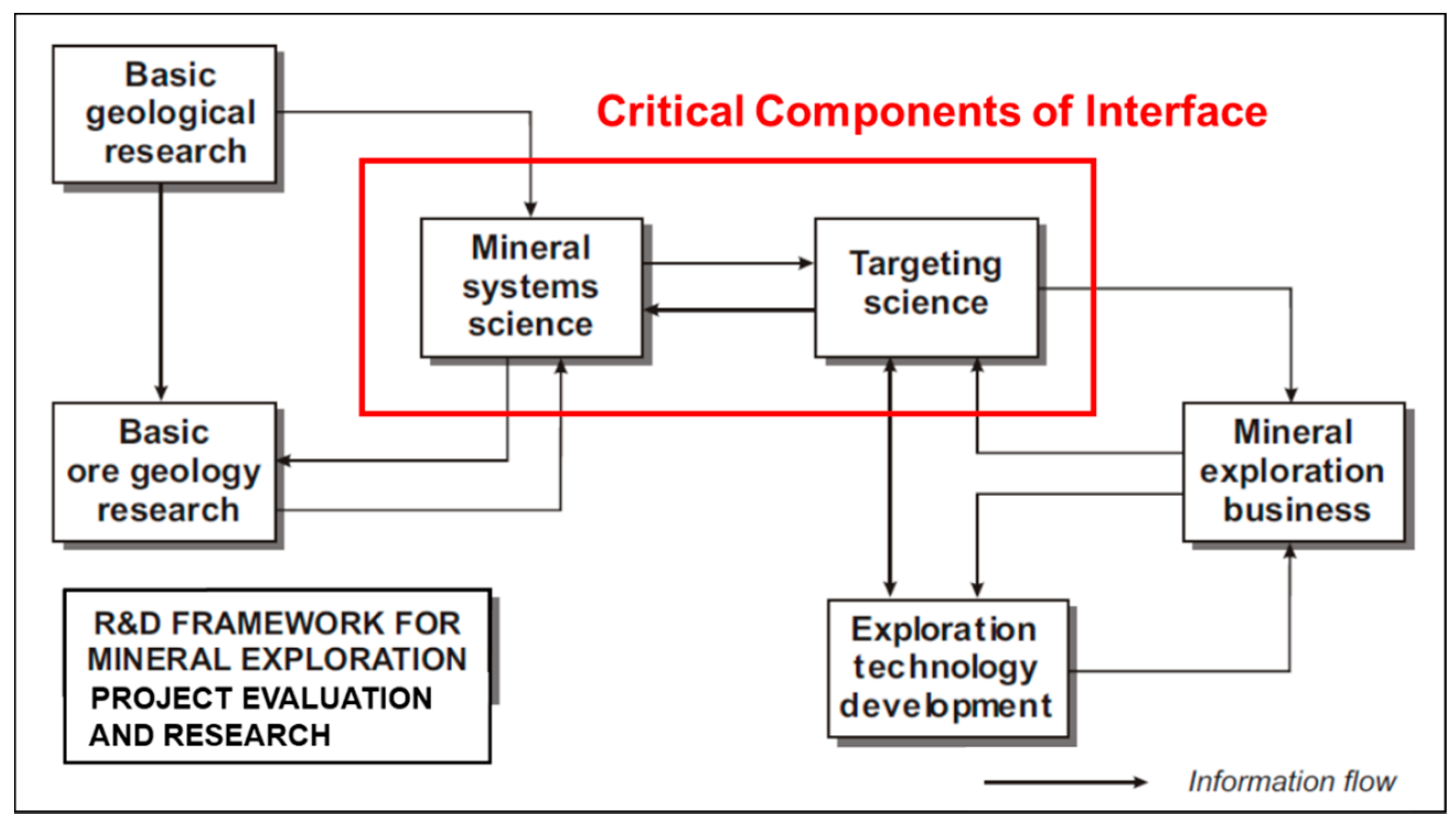
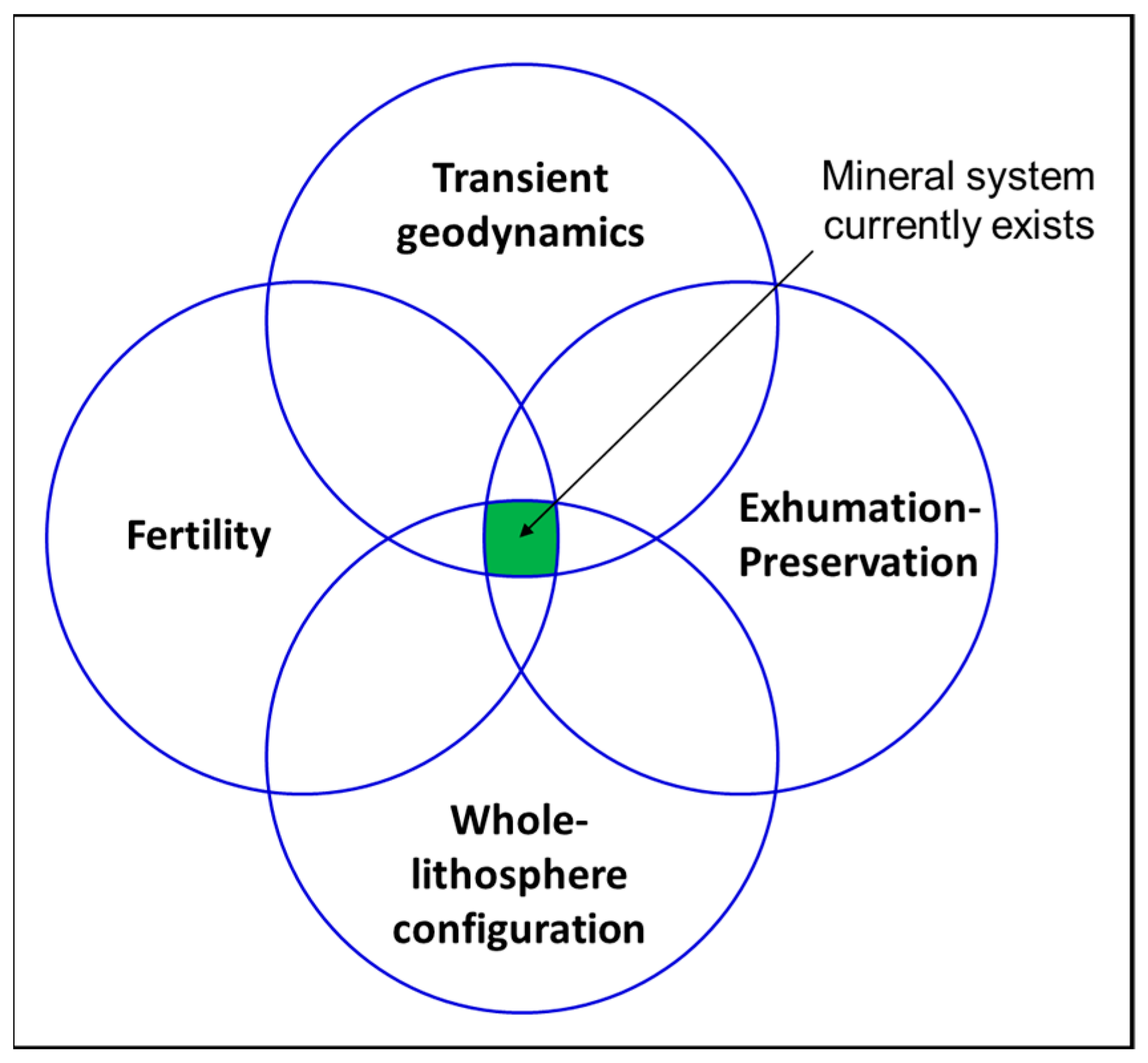

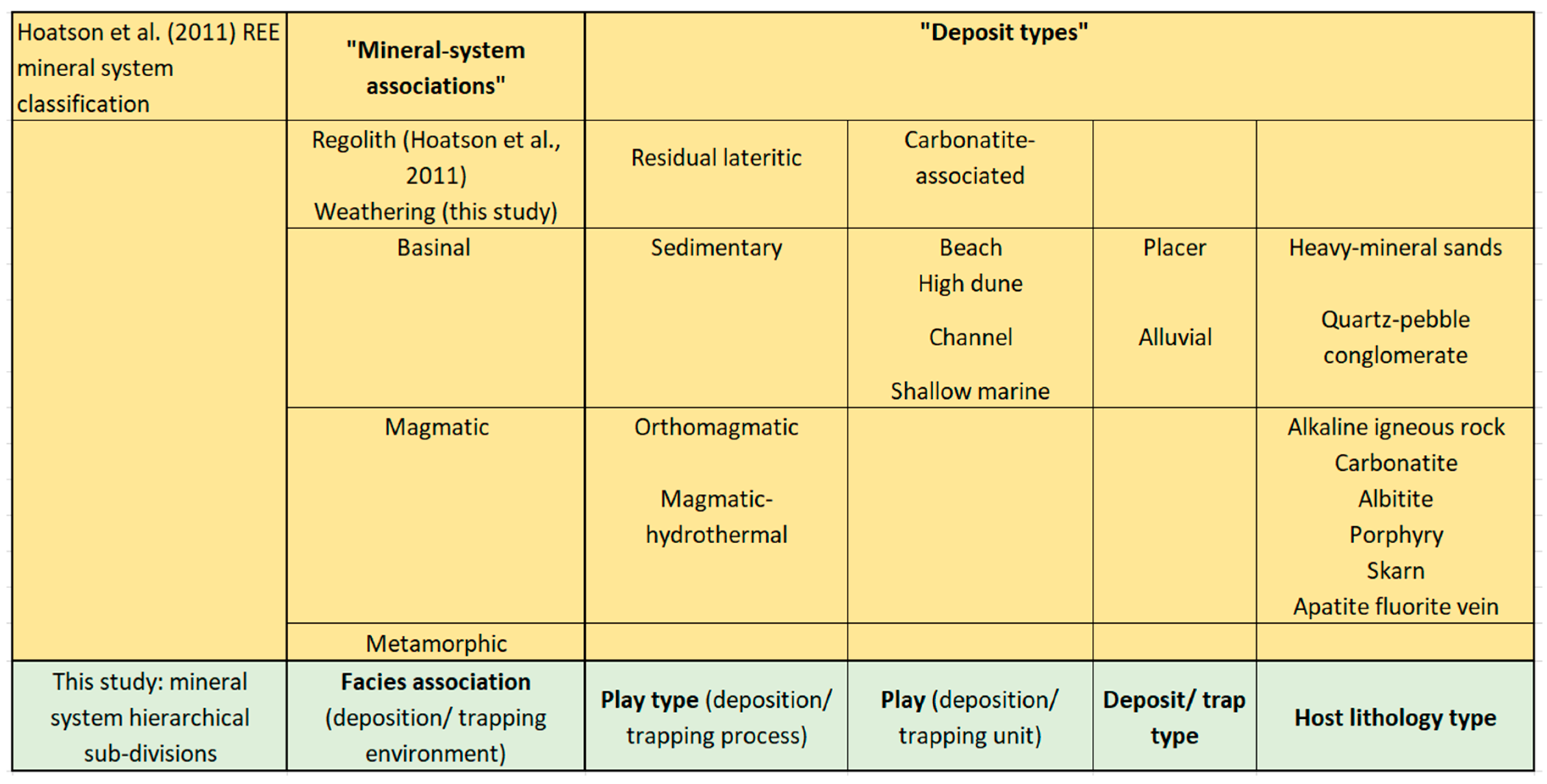
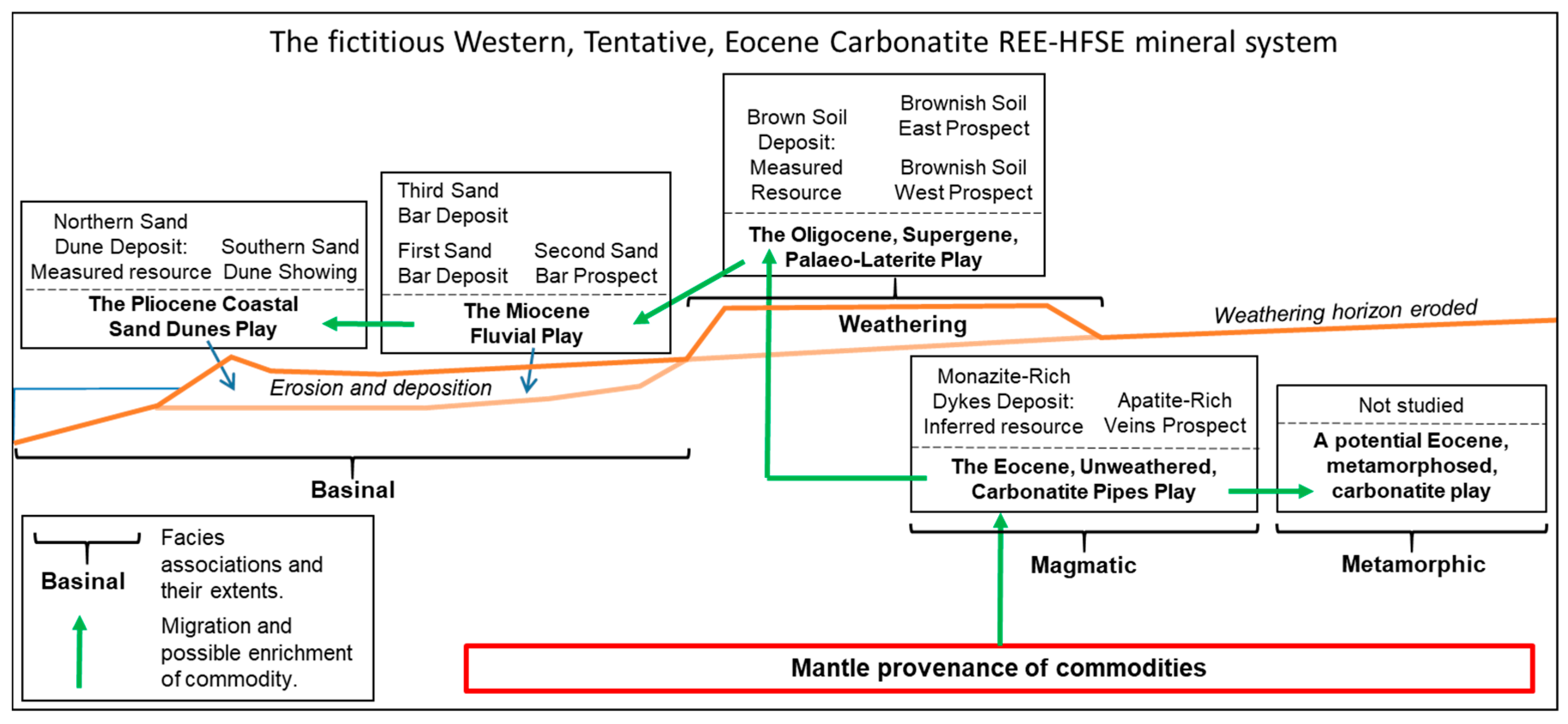
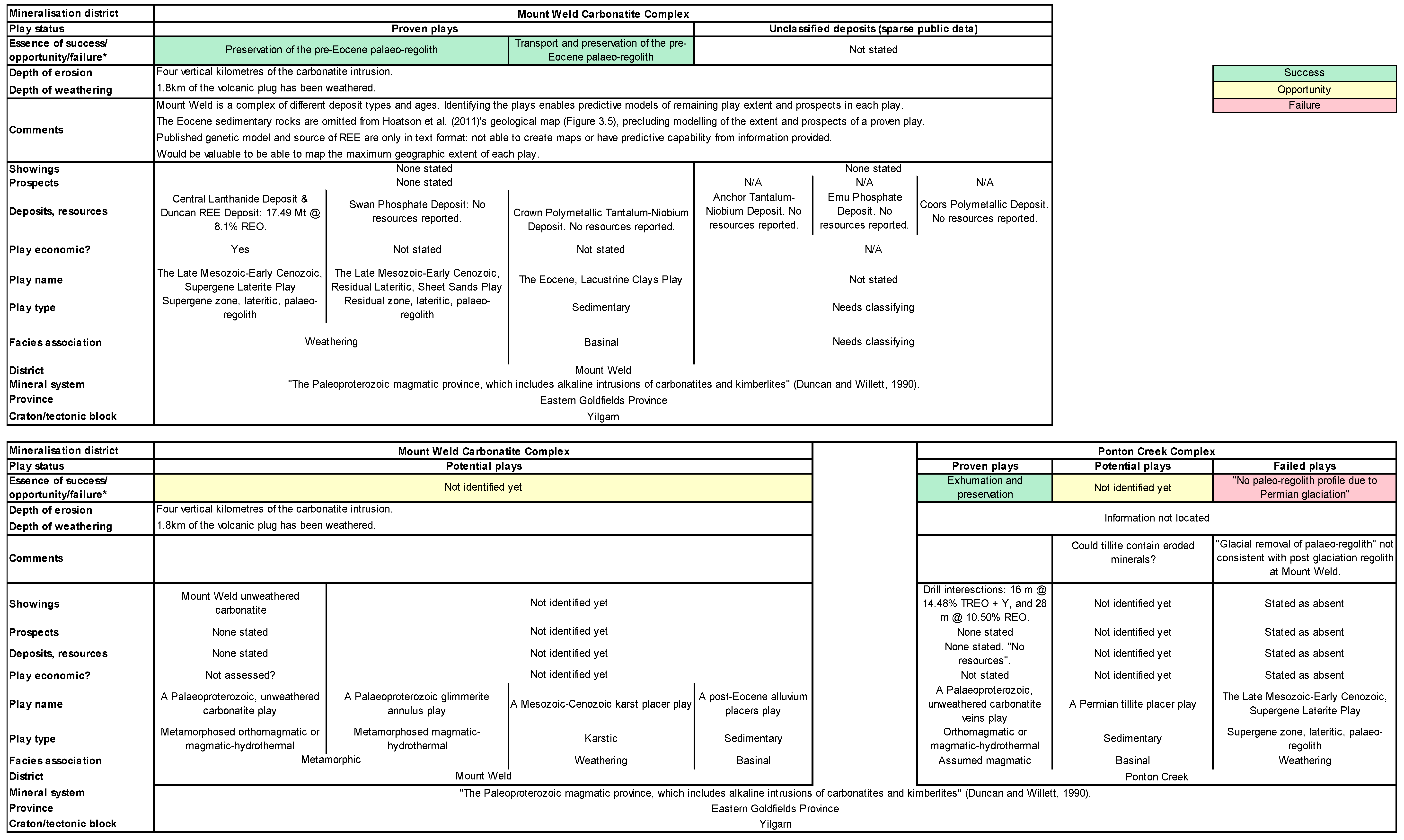
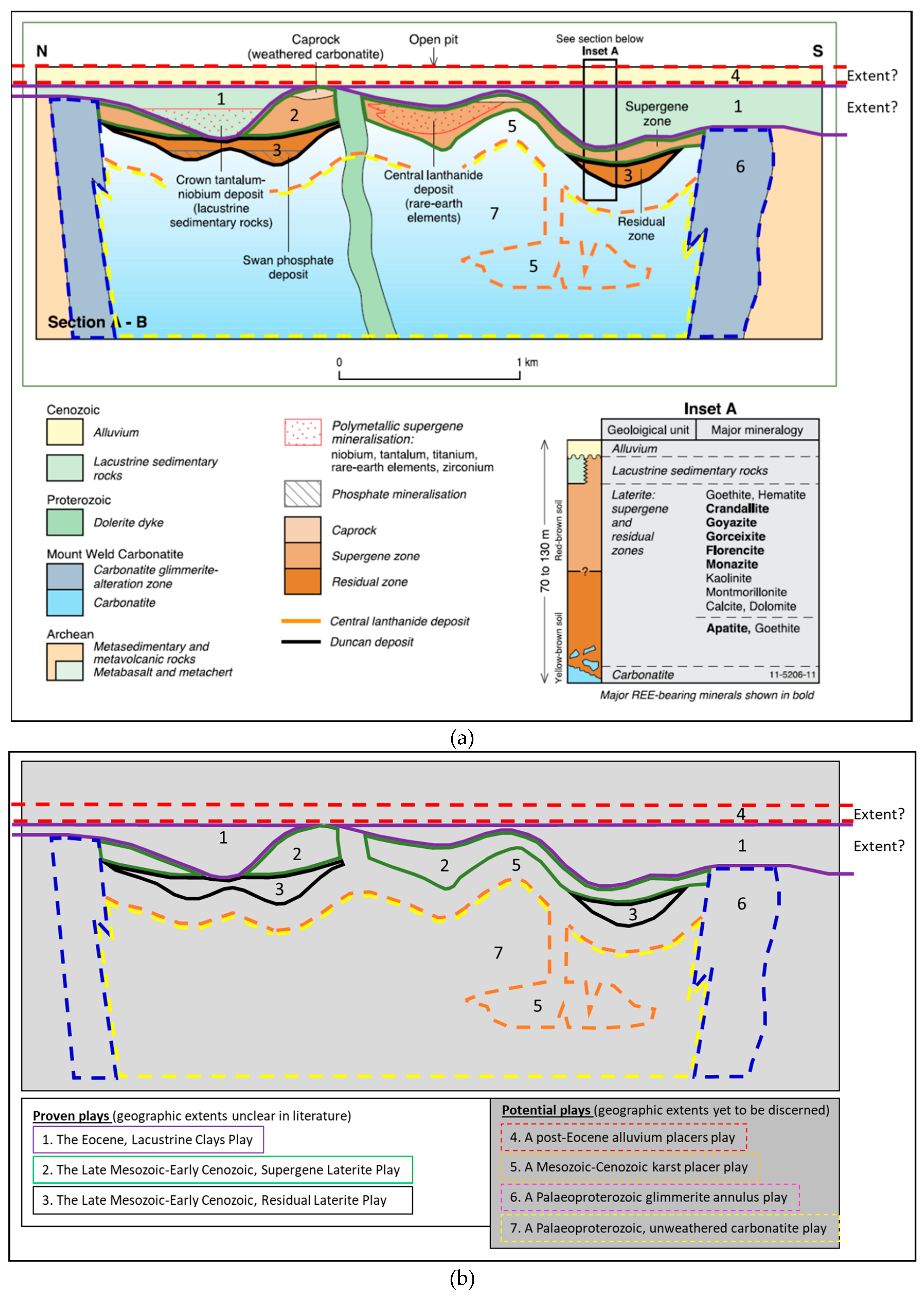
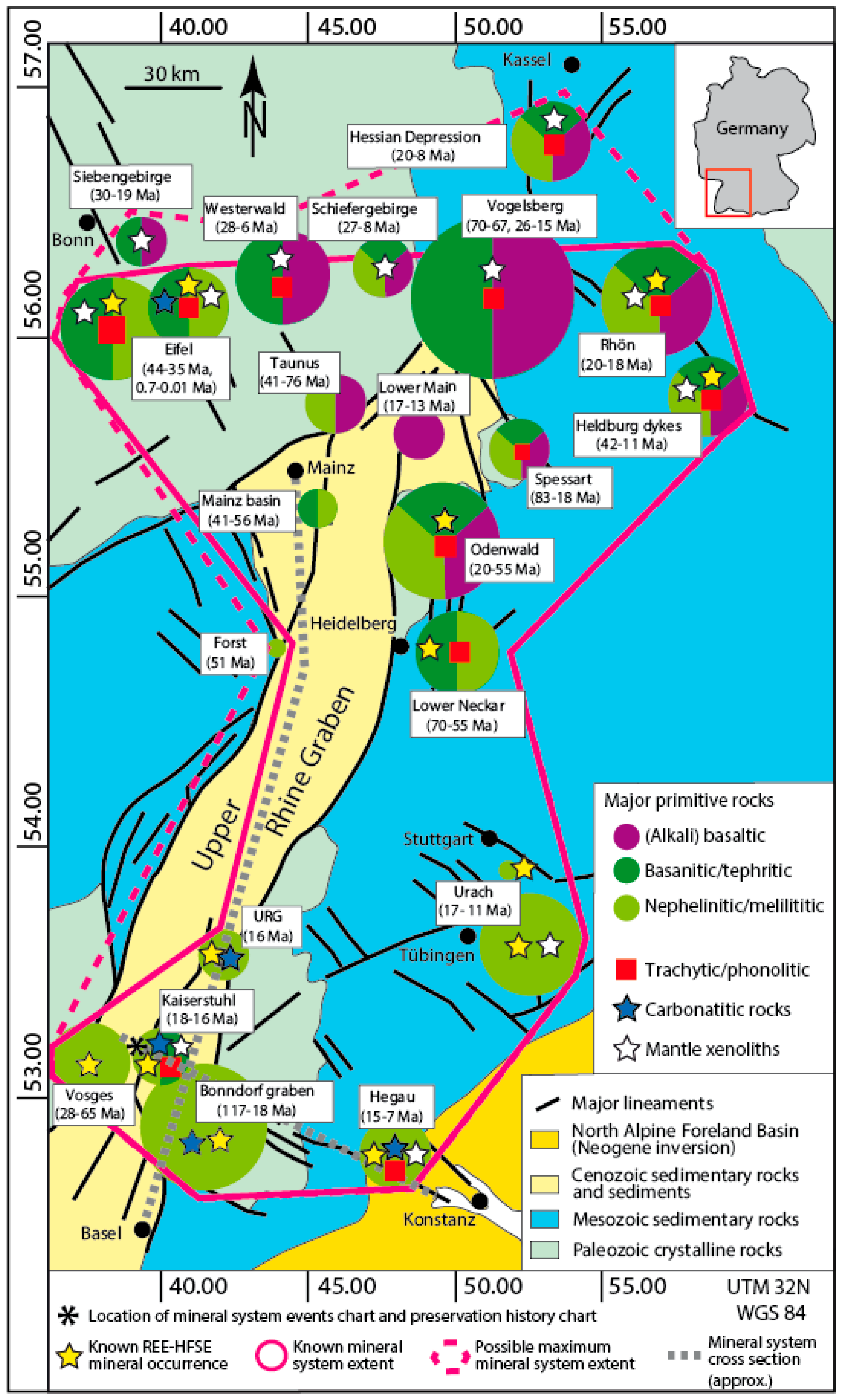
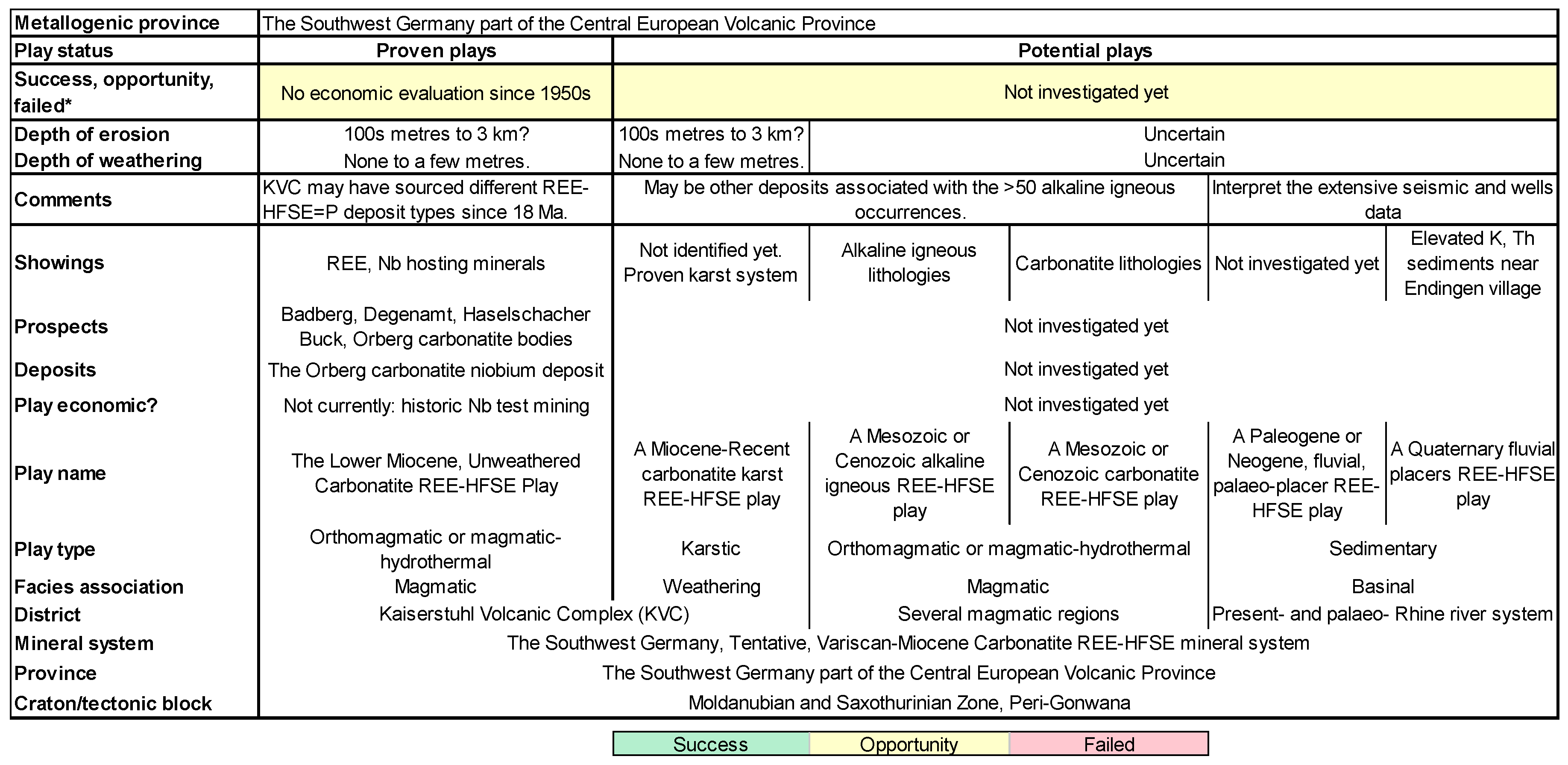
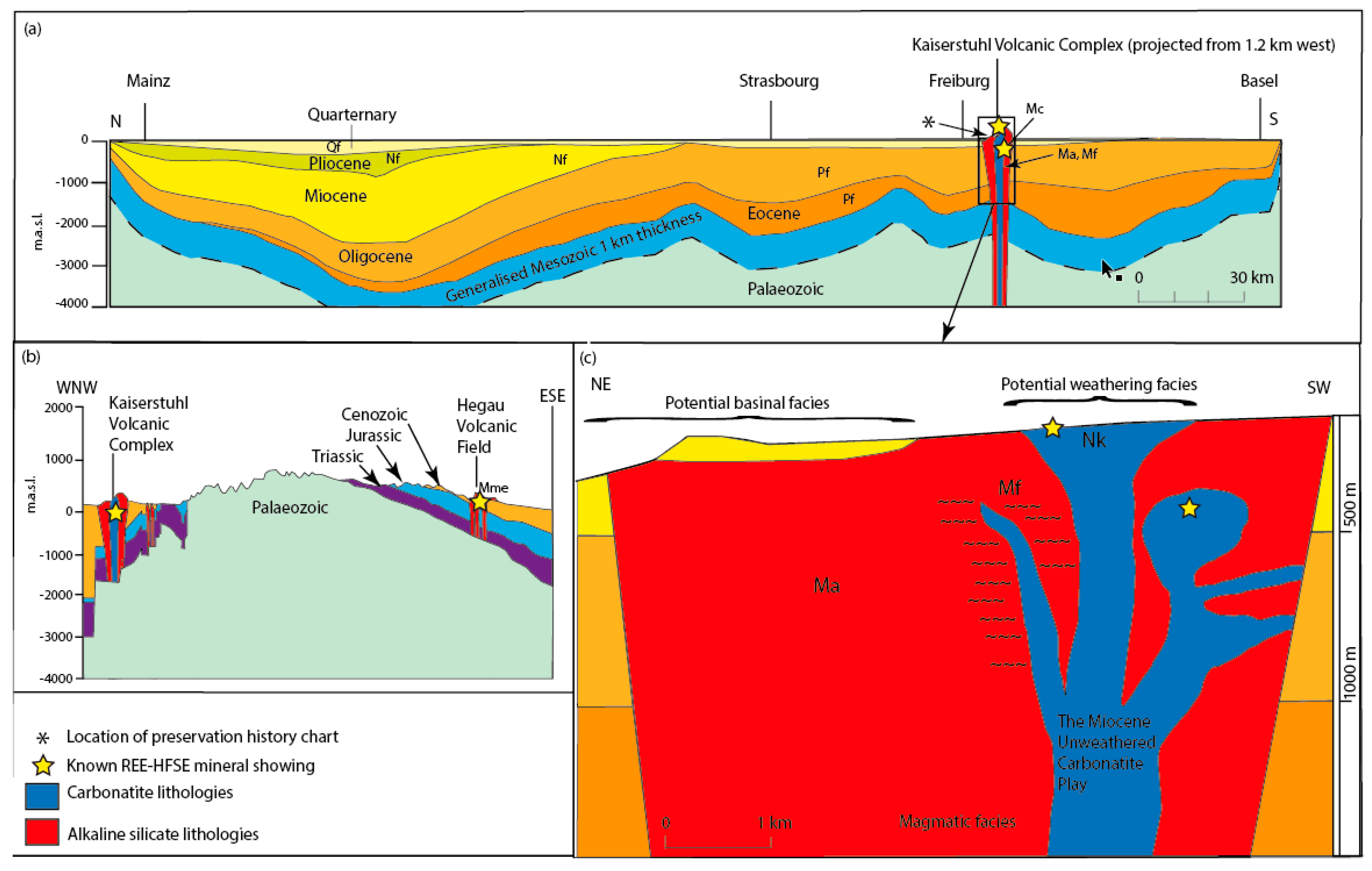
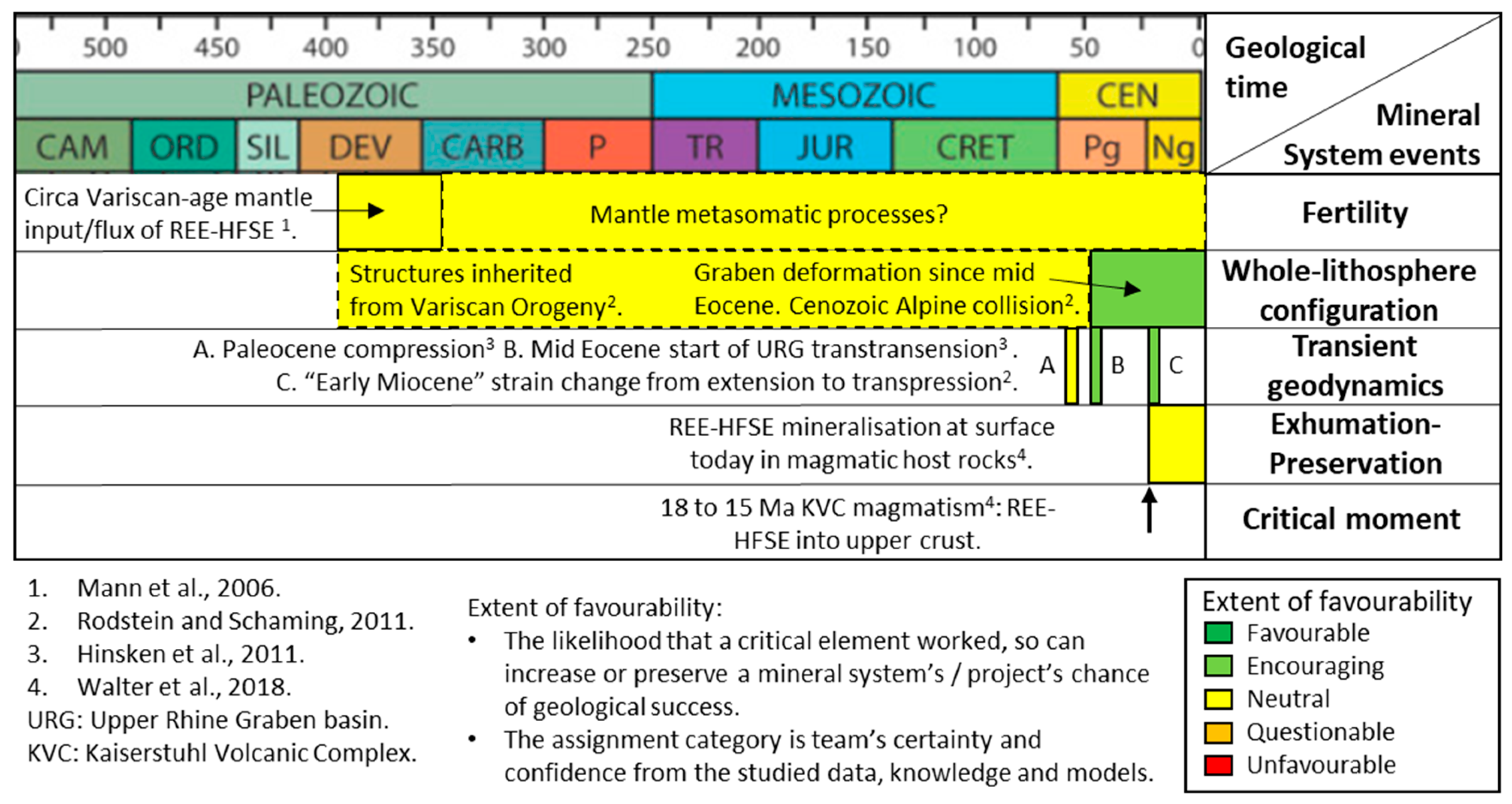
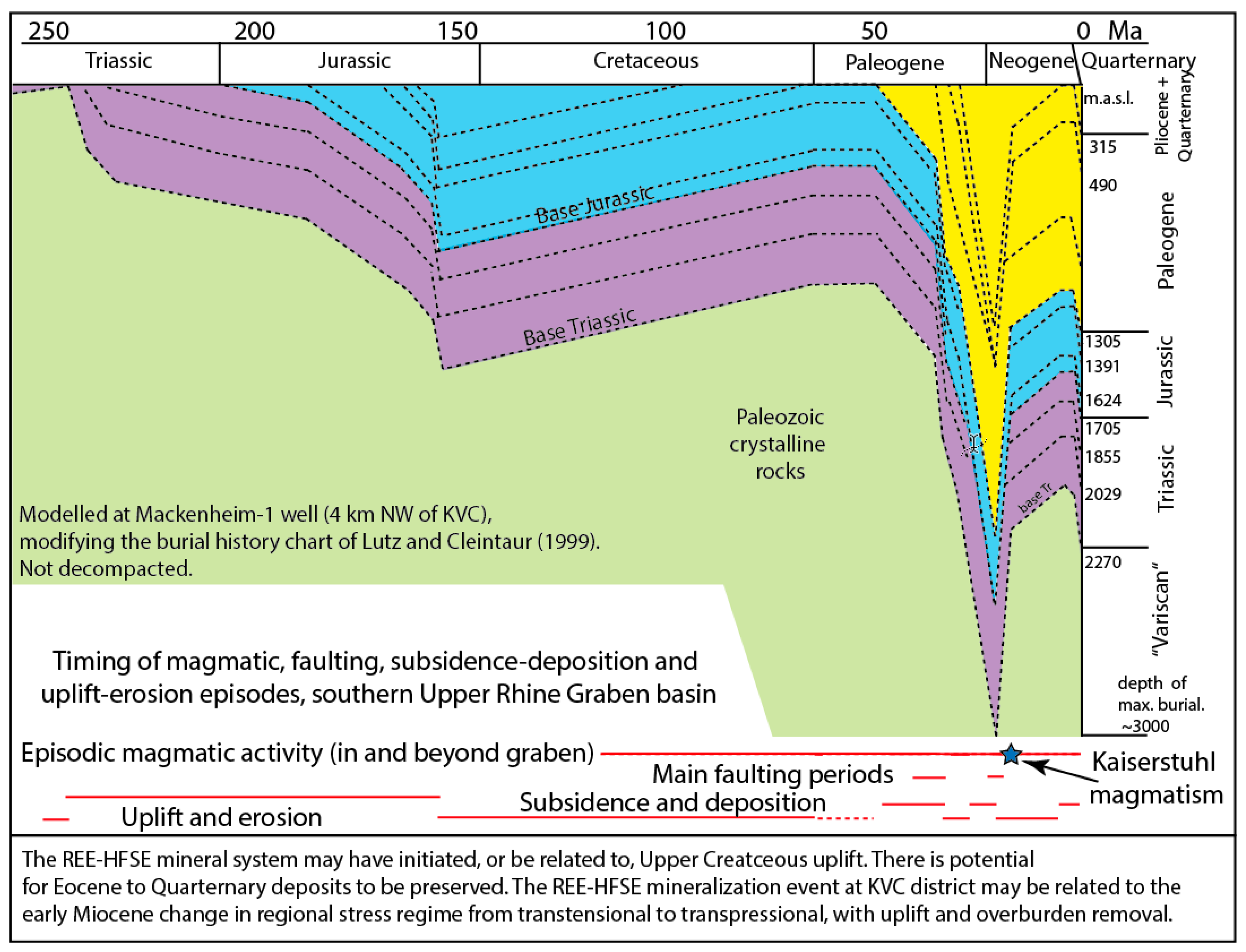
| Workflow Sequence | Workflow Tasks |
|---|---|
| 1 | Organise and summarise all Province Framework stage data and knowledge. |
| 2 | State the mineral system’s critical components and the project’s investigation products: |
| 2.1 | State the mineral system’s critical components. |
| 2.2 | List the investigation products. |
| 3 | Identify the mineral system: |
| 3.1 | Find mineralisation. |
| 3.2 | Determine the links within the mineral system: |
| 3.2.1 | Link and group genetically related occurrences. |
| 3.2.2 | Identify the source using occurrences–provenance correlations. |
| 3.2.3 | Locate the general area of the provenance. |
| 4 | Hierarchically organise the mineral system’s sub-divisions: |
| 4.1 | Facies associations and enrichment vectors. |
| 4.2 | Play types. |
| 4.3 | Plays. |
| 4.4 | Mineralisation types and host lithologies. |
| 5 | Estimate the known mineral endowment of the mineral system: |
| 5.1 | Resource volumes. |
| 5.2 | Yield–mineralisation efficiency. |
| 6 | Name the mineral system. |
| 7 | Map the mineral system’s known extent: |
| 7.1 | Geographic extent. |
| 7.2 | Stratigraphic extent. |
| 7.3 | Temporal extent: |
| 7.3.1 | Critical moment. |
| 7.3.2 | Preservation time. |
| 8 | Summarise the mineral system’s favourability for undiscovered mineral endowment. |
| 8.1 | List the potential play types, plays and mineralisation occurrences. |
| 8.2 | List and compare appropriate analogues. |
| 8.3 | Summarise the favourability of the four critical components of that facies association. |
| 8.4 | Translate the critical components into mappable, targeting criteria and their proxies. |
| 8.5 | Map the mineral system’s maximum possible extent. |
| Resource Name | Discovery Year | Play Name | Commodity | Produced Mineral Resources (e.g., Tonnes) | Unrecovered Mineral Resources (e.g., Tonnes) | |
|---|---|---|---|---|---|---|
| X | ||||||
| Y | ||||||
| Z | ||||||
| Total (tonnes) | sum | + | sum |
| Level of Certainty | Criteria |
|---|---|
| Proven | A clear, positive correlation between mineral occurrences and provenance. |
| Tentative | Positive geochemical evidence in the absence of a mineral occurrence-provenance correlation. |
| Speculative | Mineralogical or geophysical inference. |
© 2019 by the authors. Licensee MDPI, Basel, Switzerland. This article is an open access article distributed under the terms and conditions of the Creative Commons Attribution (CC BY) license (http://creativecommons.org/licenses/by/4.0/).
Share and Cite
Banks, G.J.; Walter, B.F.; Marks, M.A.W.; Siegfried, P.R. A Workflow to Define, Map and Name a Carbonatite- or Alkaline Igneous-Associated REE-HFSE Mineral System: A Case Study from SW Germany. Minerals 2019, 9, 97. https://doi.org/10.3390/min9020097
Banks GJ, Walter BF, Marks MAW, Siegfried PR. A Workflow to Define, Map and Name a Carbonatite- or Alkaline Igneous-Associated REE-HFSE Mineral System: A Case Study from SW Germany. Minerals. 2019; 9(2):97. https://doi.org/10.3390/min9020097
Chicago/Turabian StyleBanks, Graham J., Benjamin F. Walter, Michael A.W. Marks, and Pete R. Siegfried. 2019. "A Workflow to Define, Map and Name a Carbonatite- or Alkaline Igneous-Associated REE-HFSE Mineral System: A Case Study from SW Germany" Minerals 9, no. 2: 97. https://doi.org/10.3390/min9020097
APA StyleBanks, G. J., Walter, B. F., Marks, M. A. W., & Siegfried, P. R. (2019). A Workflow to Define, Map and Name a Carbonatite- or Alkaline Igneous-Associated REE-HFSE Mineral System: A Case Study from SW Germany. Minerals, 9(2), 97. https://doi.org/10.3390/min9020097





